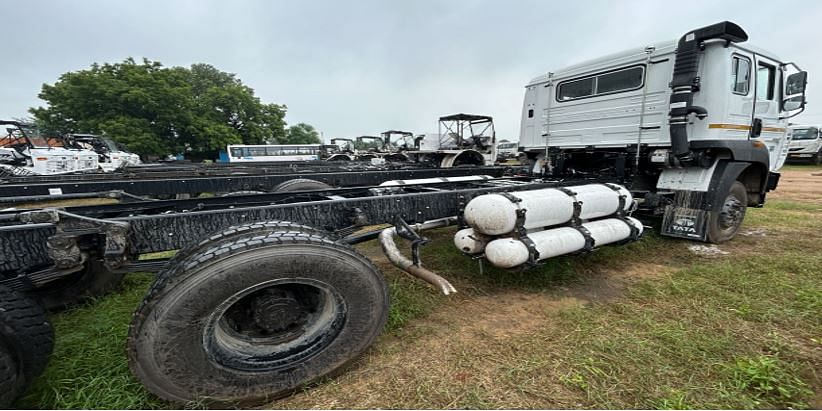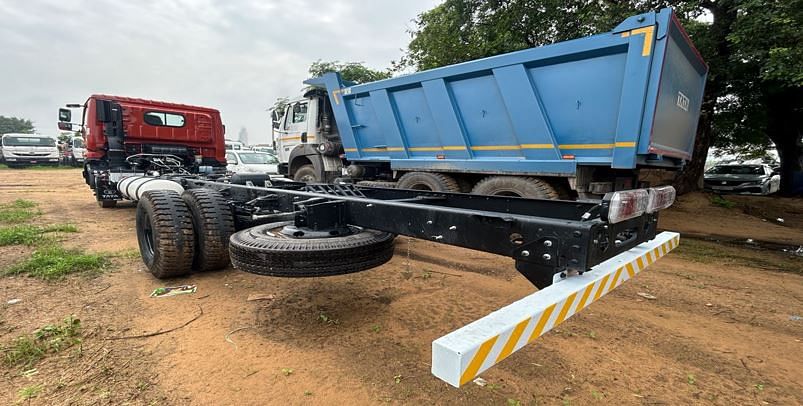Truck Chassis and Its Types: A Comprehensive Overview

The chassis houses all of the essential components that push the vehicle, direct its movement, stop it, and allow it to operate smoothly over uneven surfaces. In this article, we will go over the Chassis, its function, types, and frames, as well as their functions.
The chassis is the backbone of any vehicle, providing structural support and acting as the base for the entire vehicle. The skeleton combines all of the major components of the vehicle which includes the engine, transmission, suspension, and body. In this article, we will discuss about chassis and its functions and types.
What is a chassis?
The term "chassis" is a French word that originally referred to the frame or basic framework of a vehicle. The chassis is the most critical component of a vehicle, although few people pay attention to it. The chassis houses all of the essential components that push the vehicle, direct its movement, stop it, and allow it to operate smoothly over uneven surfaces. It is also known as a carrying unit because all of the components, including the body, are mounted on it.
Functions of Truck Chassis
Chassis constructs with long sections called longitudinal members located on either side. The longitudinal members and side members fit together with the help of rivets and bolts. Further, there are generally 5-6 cross members that provide stability and strength to the chassis. For facilitating torsional rigidity, diagonal cross bracing is present in the chassis. Below are some of the key essential roles and functions of the truck chassis.
-Support Body Weight: The manufacturing of chassis technology for a truck relies primarily on the load-bearing capacity of the truck chassis. This capacity supports the body weight of the truck. Brackets provided in the chassis frames help to mount different weights of components like the engine, suspension leaf springs, brake shafts, and others.
-Support Truck’s Accessories: An extended part of the truck frame over the front axle is the front overhang, while beyond the rear axle is the rear overhang. Trucks’ accessories like clutch, transmission and engine aggregates rivet together into an assembly. Additionally, the front overhang of the truck chassis mounts these components by using rubber blocks.
- Support Power & Control System: All the members used in constructing the chassis frame build with pressed steel. Pressed steel helps to protect the power and control system of the truck from engine vibrations. The members, like rubber blocks, not only support a truck’s power system (engine) but also isolate the engine from road shocks. Heavy truck chassis is different from a car’s chassis due to the higher loads carried by its power system with continued operations.
- Space For Passengers: The truck chassis working is to maintain the shape of the truck, which further ensures the appropriate space for passengers. Longitudinal members of the chassis frame move upswept in the front & rear, giving proper space for the axle’s movement. In addition, this lowers the frame height with a smaller turning circle to give a better steering lock.
- Provide Aerodynamic Design: With the perfect aerodynamic design, the drag truck chassis reduces the air-dragging force. It helps in enhancing the truck’s performance and productivity. The custom truck frames maintain stability and help in providing a contemporary design. Furthermore, the aerodynamic design depends on the types of chassis frames.

Types of Truck Chassis
Different types of truck chassis are available in the automobile industry for various applications. Commercial vehicles Chassis are mainly divided into two types: conventional and non-conventional.
Conventional Chassis: It is also referred to as a non-load-carrying frame. This traditional chassis is constructed as a separate item and is linked with a ladder frame. This supports all systems such as the brake system, transmission system, suspension system, and so on. Heavy-duty trucks and SUVs typically use these chassis structures. Loads on the vehicle are passed to the suspension system via the frame. In this, fuel consumption is higher as compared to Non-Conventional Chassis. This type of truck chassis is stronger and can carry more weight. It is easy to repair.
Non-Conventional Chassis: It is sometimes referred to as a frameless chassis or a unibody chassis. This chassis does not have a ladder frame; instead, the body serves as a frame. It also supports all of the vehicle's elements and components. These Chassis consume less fuel. It is difficult to repair. Luxury trucks use this type of chassis.
Types of chassis based on engine location
Full forward chassis: In this type of Chassis, the engine is installed inside the driver compartment or seats, like in cars and older Tata trucks. The driver's seat is separated from the front wheel in this configuration. As a result, the driver of the truck sits over the front wheels. The driver can see the road surface in front of the tyres with this engine configuration.
Semi forward: In this chassis, half of the engine is located in the driver's cabin, while the other half is located outside of the cabin. It improves the driver's visibility on the road.
Bus Chassis: The entire engine is housed in the driver compartment with this style of chassis. It increases the amount of floor space in the vehicle. The driver's seat is elevated above the front wheels, and he can see the entire front road from the front wheels.
Engine in front: Most vehicles have the engine mounted in the front of the chassis. The front wheels provide power. The engine can also be installed at the back of the chassis. This configuration does not necessitate a long propeller shaft. The gearbox and differential are merged into a single unit.
Engine at the centre: In this, the engine is installed in the middle of the chassis. This configuration makes use of the entire chassis floor. It is also known as Mid-engine chassis. The main benefit of this is it improves the wheel grip and provides greater aerodynamic efficiency.

Types of chassis based on Frame Types
Ladder Frame Chassis: Ladder frame chassis is one of the most traditional and common types used in commercial vehicles. Ladder frames are known for their load-bearing capacity and ability to handle rough terrains. It consists of two parallel longitudinal beams (rails) connected by cross-members, resembling a ladder. This design offers excellent strength and durability, making it suitable for heavy-duty trucks, buses, and SUVs.
Monocoque Chassis: Monocoque is a chassis design where the vehicle's body and frame are integrated into a single structure. It is also known as unibody. Monocoque chassis are lightweight and offer good fuel efficiency and handling but may have limited load-carrying capacity compared to ladder frames. This one is best for passenger cars and smaller commercial vehicles like vans and crossovers.
Backbone Frame Chassis: The backbone frame chassis has a single large, central beam running the length of the vehicle, which provides excellent strength and weight distribution. This design is commonly used in trucks and buses.
Factors Affecting Truck Chassis Design
Several factors influence truck chassis design:
Payload Capacity: The chassis must be strong enough to support the intended load.
Terrain: Off-road trucks require different chassis designs compared to highway trucks.
Fuel Efficiency: Lightweight materials and aerodynamic designs help improve fuel economy.
Safety Regulations: Chassis must comply with safety standards for occupant protection and vehicle stability.
Cost: Balancing performance and cost is essential for commercial viability.
Challenges in Truck Chassis Design
Truck chassis designers face challenges such as:
Balancing Strength and Weight: Achieving optimal strength-to-weight ratio is crucial for best
Meeting Emission Standards: Designing chassis to accommodate aftertreatment systems.
Improving Fuel Efficiency: Reducing aerodynamic drag and optimizing weight distribution.
Adapting to Changing Load Patterns: Designing chassis to accommodate diverse cargo types.
In conclusion the truck chassis is a critical component that significantly impacts a vehicle's performance, efficiency, and safety. Advancements in materials, design, and manufacturing technologies continue to push the boundaries of truck chassis engineering.
Latest Truck News
View all Truck News